Category — News
Medieval Treasures from the Cleveland Museum of Art Travel to the Ghetty
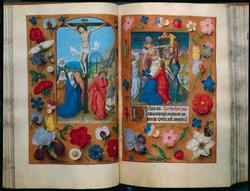 The Cleveland Museum of Art is the holder of many rare and beautiful medieval treasures including the Hours of Queen Isabella the Catholic, Queen of Spain, shown on the left. If you are in southern California this fall, you will be able to view part of this collection at the J. Paul Ghetty Museum. From the Ghetty press release:
The Cleveland Museum of Art is the holder of many rare and beautiful medieval treasures including the Hours of Queen Isabella the Catholic, Queen of Spain, shown on the left. If you are in southern California this fall, you will be able to view part of this collection at the J. Paul Ghetty Museum. From the Ghetty press release:
The Cleveland Museum of Art houses one of the finest and most comprehensive collections of Early Christian, Byzantine and European Medieval art in the world. This remarkable collection was largely acquired over a period of 90 years and formed by two of America’s most distinguished medievalists, the museum’s second director, William Milliken, and the collection’s former curator, William Wixom. The Cleveland Museum of Art’s $258 million renovation and expansion project created the opportunity for the first traveling exhibition to showcase more than 120 masterpieces in a variety of media from its medieval collection. Some of these objects will travel for the first time since they were acquired by the Cleveland Museum of Art.
“This exhibition offers a unique opportunity to bring some of the world’s finest medieval treasures to Los Angeles,†says Michael Brand, director, the J. Paul Getty Museum. â€It will present highlights from the Cleveland Museum of Art’s collection chronologically according to their place of origin, allowing visitors to appreciate the aesthetics of a particular time and place, as well as understand the general artistic progression during this significant period in European art.â€
[tags]cleveland museum of art, j. paul ghetty museum of art, medieval manuscript, medieval art[/tags]
August 22, 2007 Comments Off on Medieval Treasures from the Cleveland Museum of Art Travel to the Ghetty
The Book of Kells in the News
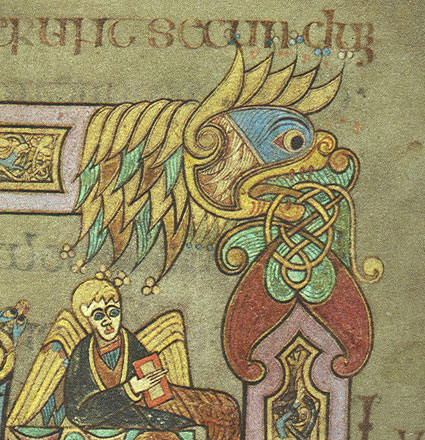
There may be no more famous example of an illuminated manscript than the Book of Kells. While it is well known as one of the most beautiful surviving illuminated manscripts, surprisingly, very little is actually known about the manuscript and its origins. Finally, modern science will be used to learn more about this treasure. From the Dublin Journal as reported in the New York Times:
Experts at Trinity College in Dublin, where the Book of Kells has resided for the past 346 years, are allowing a two-year laser analysis of the treasure, which is one of Ireland’s great tourist draws.
The 21st-century laser technology being used, Raman spectroscopy, encourages hopes among those with a romantic view for an ecclesiastical intrigue like “The Da Vinci Code†or “The Name of the Rose.â€
But the precise subjects are more mundane. The laser will study the chemicals and composition of the book, its pigments, inks and pages of fine vellum. Experts estimate that 185 calves would have been needed to create the vellum on which the art and scriptures were reproduced.
This news happens to coincide with the opening of The Medieval Scriptorium’s on-line gallery of images from the Book of Kells. I have to admit that the gallery is not complete. I haven’t had time to finish all of the captions for the images but I decided to introduce it in this post in light of the recent story referenced above.
[tags]Book of Kells, illuminated manuscript, celtic, calligraphy[/tags]
May 29, 2007 1 Comment
Medieval Scribe, John Myronas, a 13th Century Parchment Recycler
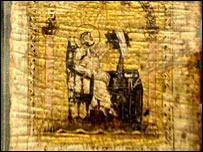 Yet another layer of history has been discovered in a Christian prayer book attributed to John Myronas. The most recent discovery is the third layer of text discovered in this recycled 13th century manuscript. In 2002, modern multi-sectional and multi-spectral imaging methods discovered greek writings from the 4th century. An article in the National Geographic News describes the earlier find:
Yet another layer of history has been discovered in a Christian prayer book attributed to John Myronas. The most recent discovery is the third layer of text discovered in this recycled 13th century manuscript. In 2002, modern multi-sectional and multi-spectral imaging methods discovered greek writings from the 4th century. An article in the National Geographic News describes the earlier find:
In 2002 researchers had uncovered writings by the mathematician Archimedes and the fourth-century B.C. politician Hyperides.
Last year one of the pages was found to contain a famous work by Archimedes about buoyancy that had previously been known only from an incomplete Latin translation.
A third layer has been been revealed and the details were presented today at the meeting of the American Philosophical Society by Reviel Netz and Roger Easton. From the BBC:
A series of clues, such as spotting a key name in the margin, led the team to its conclusion.
“The philosophical passage in the Archimedes Palimpsest is now definitely identified as a relatively early commentary to Aristotle’s Categories,” said Professor Netz.
He said that Aristotle’s Categories had served as the foundation for the study of logic throughout western history.
Further study has revealed the most likely author of this unique commentary is Alexander of Aphrodisias, Professor Robert Sharples from the University College London told BBC News.
If this is the case, he said, “it gives us part of a commentary previously supposed lost by the most important of those ancient commentators on Aristotle”.
From the National Geographic News:
n the 10th century a scribe had copied the ancient Greek manuscripts from papyrus scrolls onto parchment—thin leaves of treated animal skin.
Later the writing was washed out using a solvent such as orange juice and overwritten with new text—a process known as palimpsesting.
“In those days, parchment writing materials were so valuable that they were commonly reused when the book was considered out of date or if the subject was judged inappropriate or less valuable,” Roger L. Easton, of the Rochester Institute of Technology, wrote in an email.
By the 12th century, pages from five different earlier works had been erased, overwritten, and compiled into a Christian prayer book, the Euchologion—what is now called the Archimedes Palimpsest.
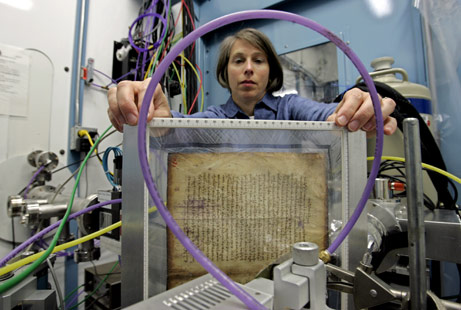
As always, books are multi-layered treasures. I wonder what else might be discovered in this 13th century prayer book?
[tags]Euchologion, Archimedes Palimpsest, Aristotle, Christian Prayer Book, 13th century, John Myronas, Philisophical Society, Archimedes, parchment, illuminated manscript[/tags]
April 26, 2007 Comments Off on Medieval Scribe, John Myronas, a 13th Century Parchment Recycler
The Bedford and Sobieski Books of Hours Now on Display at the British Library
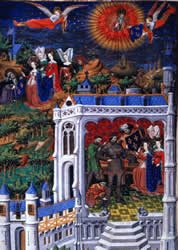 The Bedford Book of Hours is going to be on display at the British Library next week. This is one of the most magnificent illuminated manuscripts in the world. It dates from the early 15th century and every single page in the over 500 hundred page book of hours is illustrated. The illustrations and illuminations are vivid and lush. On display with the Bedford Hours is the Sobieski Hours. It is also from the early 15 century. Both illuminated masterpieces are credited to an artist known as the “Bedford Master.” From the 24 hour museum:
The Bedford Book of Hours is going to be on display at the British Library next week. This is one of the most magnificent illuminated manuscripts in the world. It dates from the early 15th century and every single page in the over 500 hundred page book of hours is illustrated. The illustrations and illuminations are vivid and lush. On display with the Bedford Hours is the Sobieski Hours. It is also from the early 15 century. Both illuminated masterpieces are credited to an artist known as the “Bedford Master.” From the 24 hour museum:
The British Library is displaying two masterpieces of medieval art together for the first time in an exhibition celebrating the 15th century artist, the ‘Bedford Master’, and the collections of the manuscript owners.
Running until July 2 2007, The Bedford Hours: Owners and Illuminators, brings the Bedford Hours and the Sobieski Hours together, both lavishly illustrated medieval manuscripts by the Bedford Master (so called in honour of his noble patron the Duke of Bedford).
The 24 hour museum continues:
The identity of the Bedford Master remains uncertain, despite his having been among the leading and most prolific painters of his day. Some scholars tentatively identify him as the Alsatian artist Haincelin of Hagenau, recorded in Paris as a court painter to the Dauphin Louis de Guyenne.
This may very well be a once in a lifetime opportunity to see the very best examples of Gothic Parisian illumination. These books are the pinnacle of Gothic calligraphic art.
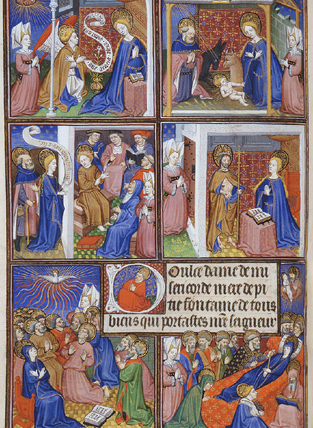
[tags]illuminated manuscripts, book of hours, bedford hours, sobieski hours, gothic alphabet, gothic calligraphy, british library[/tags]
April 16, 2007 Comments Off on The Bedford and Sobieski Books of Hours Now on Display at the British Library
England’s Medieval Books of Hours – A New Book from Eamon Duffy
 Of all the beautiful manuscripts from the Middle Ages that have survived, none is more common than Books of Hours. In fact, it has been said that “Books of Hours are now more widely scattered around the world than any other object made in the Middle Ages” ( from: “A History of Illuminated Manuscripts
Of all the beautiful manuscripts from the Middle Ages that have survived, none is more common than Books of Hours. In fact, it has been said that “Books of Hours are now more widely scattered around the world than any other object made in the Middle Ages” ( from: “A History of Illuminated Manuscripts“). Books of hours provided a framework for lay people to practice monastic devotional routines. After the upheaval of the Black Death in the 14th century, the popularity of the form surged and, by the later Middle Ages, these books were mass produced. One of the most famous and finely painted Book of Hours is the Très Riches Heures. My favorite illustration, however, is from the Hours of Catherine of Cleves, Duchess of Guelders (1417-1476). Shown below, this miniature shows an angel leading figures out of the mouth of Hell.
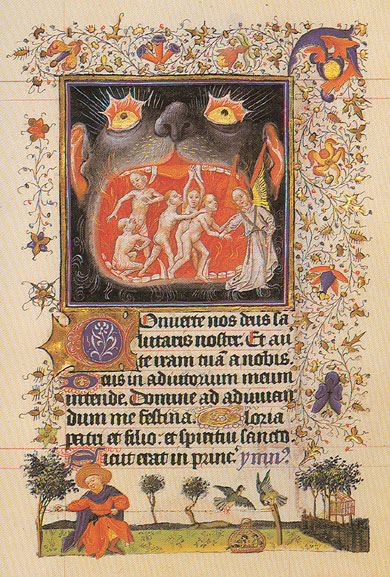
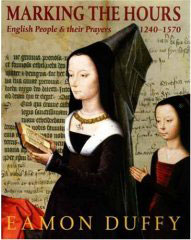 If you’re a fan of this type of illustration and calligraphy as I am, you’ll want to get your hands on a copy of a new book published on the Books of Hours by the religious historian Eamon Duffy. “Marking the Hours: English People and Their Prayers, 1240-1570
If you’re a fan of this type of illustration and calligraphy as I am, you’ll want to get your hands on a copy of a new book published on the Books of Hours by the religious historian Eamon Duffy. “Marking the Hours: English People and Their Prayers, 1240-1570” was reviewed in The Guardian recently. Duffy’s new book emphasizes the individual owners of these books. He’s most interested in the personal comments as well as the inclusion of commissioned images of the owners themselves in the beautiful miniatures. These additions are rare glimpses into the individual minds of people from the Middle Ages. From that review:
In the Middle Ages if you were female, comfortably-off and hoped to go to heaven then you almost certainly possessed a Book of Hours. Tucked up your sleeve or kept close by in a special place, the Book was your spiritual guide to the ordinary day. It didn’t speak intimately, nor was it interested in your particular circumstances. Instead it marked the passing of the liturgical “hours” – Matins, Prime, Vespers – giving you a set of prayers and psalms to raise your spirits as you negotiated a schedule more immediately concerned with sulky servants and sickly children than the glories of the Risen Christ.
The review in The Guardian continues:
The kinds of scrawls that people added to their Book of Hours included the names of favourite saints – Apollonia was good for toothache, while Zita was helpful with lost keys. If you were sufficiently rich and important you could get the artist to include a specially commissioned picture of yourself at the front of the book perhaps even – tricksy this – showing yourself reading the very Book of Hours in which you now metaphorically resided. There was even the option of getting yourself inserted into standard biblical scenes. One woman had herself painted as a spectator at the Annunciation, muscling in on Mary and Gabriel’s special moment. Others, more tactfully, waited until the Virgin was actually in heaven and had themselves painted floating on a nearby cloud.
I find this type of history fascinating and I’ve already pre-ordered my copy of Duffy’s book.
[tags]book of hours, eamon duffy, illuminated manuscript, calligraphy, medieval history, middle ages[/tags]
December 30, 2006 Comments Off on England’s Medieval Books of Hours – A New Book from Eamon Duffy

